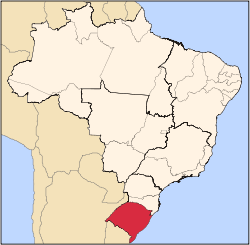Brazilian wine

While Brazil has a relatively large number of vineyards, a large part of them produce table grapes, and only some produce Brazilian wine. As much of Brazil is close to the equator, traditional rules of thumb brand most of the country unsuitable for viticulture, due to too much heat and humidity. Most of the wine production of Brazil is concentrated in the south of the country, away from the equator, in the state of Rio Grande do Sul, around 29th parallel south, which is close to Uruguay and Argentina. In that area, many of the vineyards are also located in cooler high and hilly locations, to a large extent in Serra Gaúcha region.
While better quality wines (vinho fino) are produced from the European grapevine Vitis vinifera, in 2003 only some 5,000 hectares (12,000 acres) out of Brazil's 68,000 hectares (170,000 acres) were planted with such vines.[1] The rest are American vines or hybrid vines, many of which are easier to cultivate under Brazilian growing conditions.
History
Several less successful attempts at introducing European vines into Brazil were made during the centuries. The first vines were brought to Brazil by the Portuguese in 1532, who planted them in the state São Paulo. Jesuits brought Spanish vines to Rio Grande do Sul in 1626, and 18th century settlers from the Azores brought vine cuttings from Madeira and the Azores. 1840 plantations of Isabella (a cultivar of the species Vitis labrusca) on the south coast of Rio Grande are considered the first successful vine plantations in Brazil. By the late 1870s, winemaking was more definitely established and had taken hold in Serra Gaúcha, where Italian immigrants did much of the vine-growing, and mostly American vines were produced. Some Italian varieties and Tannat were later added.[1]
Wine production with higher quality ambitions started in the 1970s, when several international wine companies such as Moet & Chandon [2] invested in Brazil in the 1970s and brought in know-how and modern equipment.
References
- 1 2 Jancis Robinson, ed. (2006). "Brazil". Oxford Companion to Wine (Third ed.). Oxford: Oxford University Press. pp. 102–103. ISBN 0-19-860990-6.
- ↑ http://riotimesonline.com/brazil-news/rio-business/brazilian-winemakers-ready-for-the-season/#